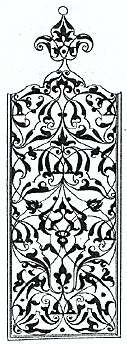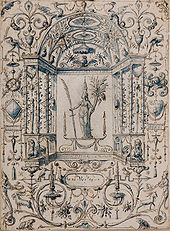
The arabesque is a form of artistic decoration consisting of "surface decorations based on rhythmic linear patterns of scrolling and interlacing foliage, tendrils" or plain lines, often combined with other elements. Another definition is "Foliate ornament, used in the Islamic world, typically using leaves, derived from stylised half-palmettes, which were combined with spiralling stems". It usually consists of a single design which can be 'tiled' or seamlessly repeated as many times as desired. Within the very wide range of Eurasian decorative art that includes motifs matching this basic definition, the term "arabesque" is used consistently as a technical term by art historians to describe only elements of the decoration found in two phases: Islamic art from about the 9th century onwards, and European decorative art from the Renaissance onwards. Interlace and scroll decoration are terms used for most other types of similar patterns.

Since at least the 18th century, grotesque has come to be used as a general adjective for the strange, mysterious, magnificent, fantastic, hideous, ugly, incongruous, unpleasant, or disgusting, and thus is often used to describe weird shapes and distorted forms such as Halloween masks. In art, performance, and literature, however, grotesque may also refer to something that simultaneously invokes an audience feeling of uncomfortable bizarreness as well as sympathetic pity.

Mudéjar art, or Mudéjar style, was a type of ornamentation and decoration used in the Iberian Christian kingdoms, primarily between the 13th and 16th centuries. It was applied to Romanesque, Gothic and Renaissance architectural styles as constructive, ornamental and decorative motifs derived from those that had been brought to or developed in Al-Andalus. These motifs and techniques were also present in the art and crafts, especially Hispano-Moresque lustreware that was once widely exported across Europe from southern and eastern Spain at the time.
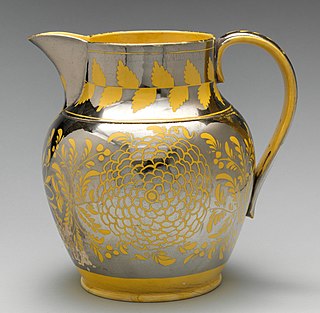
Lustreware or lusterware is a type of pottery or porcelain with a metallic glaze that gives the effect of iridescence. It is produced by metallic oxides in an overglaze finish, which is given a second firing at a lower temperature in a "muffle kiln", or a reduction kiln, excluding oxygen.
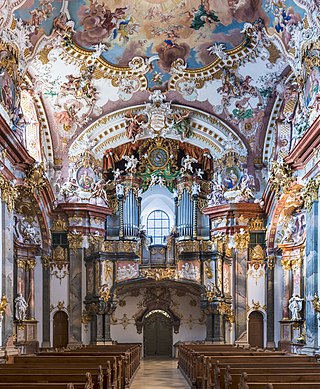
In architecture and decorative art, ornament is decoration used to embellish parts of a building or object. Large figurative elements such as monumental sculpture and their equivalents in decorative art are excluded from the term; most ornaments do not include human figures, and if present they are small compared to the overall scale. Architectural ornament can be carved from stone, wood or precious metals, formed with plaster or clay, or painted or impressed onto a surface as applied ornament; in other applied arts the main material of the object, or a different one such as paint or vitreous enamel may be used.

Islamic pottery occupied a geographical position between Chinese ceramics, and the pottery of the Byzantine Empire and Europe. For most of the period, it made great aesthetic achievements and influence as well, influencing Byzantium and Europe. The use of drinking and eating vessels in gold and silver, the ideal in ancient Rome and Persia as well as medieval Christian societies, is prohibited by the Hadiths, with the result that pottery and glass were used for tableware by Muslim elites, as pottery also was in China but was much rarer in Europe and Byzantium. In the same way, Islamic restrictions greatly discouraged figurative wall painting, encouraging the architectural use of schemes of decorative and often geometrically patterned titles, which are the most distinctive and original speciality of Islamic ceramics.

Hispano-Moresque ware is a style of initially Islamic pottery created in Al-Andalus, which continued to be produced under Christian rule in styles blending Islamic and European elements. It was the most elaborate and luxurious pottery being produced in Europe until the Italian maiolica industry developed sophisticated styles in the 15th century, and was exported over most of Europe. The industry's most successful period was the 14th and 15th centuries.
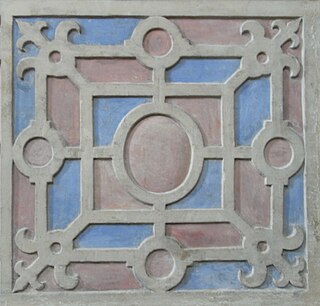
In the history of art and design, strapwork is the use of stylised representations in ornament of ribbon-like forms. These may loosely imitate leather straps, parchment or metal cut into elaborate shapes, with piercings, and often interwoven in a geometric pattern. In early examples there may or may not be three-dimensionality, either actual in curling relief ends of the elements, or just represented in two dimensions. As the style continued, these curling elements became more prominent, often turning into scrollwork, where the ends curl into spirals or scrolls. By the Baroque scrollwork was a common element in ornament, often partly submerged by other rich ornament.

Cosmatesque, or Cosmati, is a style of geometric decorative inlay stonework typical of the architecture of Medieval Italy, and especially of Rome and its surroundings. It was used most extensively for the decoration of church floors, but was also used to decorate church walls, pulpits, and bishop's thrones. The name derives from the Cosmati, the leading family workshop of craftsmen in Rome who created such geometrical marble decorations.

The scroll in art is an element of ornament and graphic design featuring spirals and rolling incomplete circle motifs, some of which resemble the edge-on view of a book or document in scroll form, though many types are plant-scrolls, which loosely represent plant forms such as vines, with leaves or flowers attached. Scrollwork is a term for some forms of decoration dominated by spiralling scrolls, today used in popular language for two-dimensional decorative flourishes and arabesques of all kinds, especially those with circular or spiralling shapes.

Saint-Porchaire ware is the earliest very high quality French pottery. It is white lead-glazed earthenware, often conflated with true faience, that was made for a restricted French clientele from perhaps the 1520s to the 1550s. Only about seventy pieces of this ware survive, all of them well known before World War II. None have turned up in the last half-century. It is characterized by the use of inlays of clay in a different coloured clay, and, as Victorian revivalists found, is extremely difficult to make.

A Dutch gable or Flemish gable is a gable whose sides have a shape made up of one or more curves and which has a pediment at the top. The gable may be an entirely decorative projection above a flat section of roof line, or may be the termination of a roof, like a normal gable. The preceding is the strict definition, but the term is sometimes used more loosely, though the stepped gable should be distinguished from it. The term "Dutch gable" is also used in America and Australasia to refer to a gablet roof.
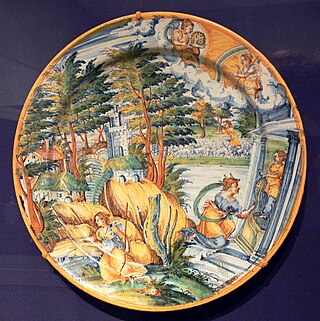
Tin-glazed pottery is earthenware covered in lead glaze with added tin oxide which is white, shiny and opaque ; usually this provides a background for brightly painted decoration. It has been important in Islamic and European pottery, but very little used in East Asia. The pottery body is usually made of red or buff-colored earthenware and the white glaze imitated Chinese porcelain. The decoration on tin-glazed pottery is usually applied to the unfired glaze surface by brush with metallic oxides, commonly cobalt oxide, copper oxide, iron oxide, manganese dioxide and antimony oxide. The makers of Italian tin-glazed pottery from the late Renaissance blended oxides to produce detailed and realistic polychrome paintings.

Moresca (Italian), morisca (Spanish), mourisca (Portuguese) or moresque, mauresque (French), also known in French as the danse des bouffons, is a dance of exotic character encountered in Europe in the Renaissance period. This dance usually took form of medieval wars in Spain between Moors and Christians. Elements of moresca include blackening of the face, bells attached to the costumes and, in occasions, men disguised as women to portray fools. An example of the moresca can be seen in Franco Zeffirelli's 1968 production of Romeo and Juliet, which has a scene with both Juliet and Romeo dancing the moresca in a circle.

Islamic ornament is the use of decorative forms and patterns in Islamic art and Islamic architecture. Its elements can be broadly divided into the arabesque, using curving plant-based elements, geometric patterns with straight lines or regular curves, and calligraphy, consisting of religious texts with stylized appearance, used both decoratively and to convey meaning. All three often involve elaborate interlacing in various mediums.

Islamic geometric patterns are one of the major forms of Islamic ornament, which tends to avoid using figurative images, as it is forbidden to create a representation of an important Islamic figure according to many holy scriptures.

Northern Mannerism is the form of Mannerism found in the visual arts north of the Alps in the 16th and early 17th centuries. Styles largely derived from Italian Mannerism were found in the Netherlands and elsewhere from around the mid-century, especially Mannerist ornament in architecture; this article concentrates on those times and places where Northern Mannerism generated its most original and distinctive work.

Islamic influences on Western art refers to the stylistic and formal influence of Islamic art, defined as the artistic production of the territories ruled by Muslims from the 7th century onward, on European Christian art. Western European Christians interacted with Muslims in Europe, Africa, and the Middle East and formed a relationship based on shared ideas and artistic methods. Islamic art includes a wide variety of media including calligraphy, illustrated manuscripts, textiles, ceramics, metalwork, and glass, and because the Islamic world encompassed people of diverse religious backgrounds, artists and craftsmen were not always Muslim, and came from a wide variety of different backgrounds. Glass production, for example, remained a Jewish speciality throughout the period. Christian art in Islamic lands, such as that produced in Coptic Egypt or by Armenian communities in Iran, continued to develop under Islamic rulers.
Moresche is the plural of moresca, meaning Moorish thing, or Moorish girl in Italian. Both the singular and plural can refer to both a 15th~16th century dance genre or to a 15th~16th century song genre. This article concerns the genre of moresche, polyphonic "moorish" songs.
This is an alphabetical index of articles related to the Renaissance.
